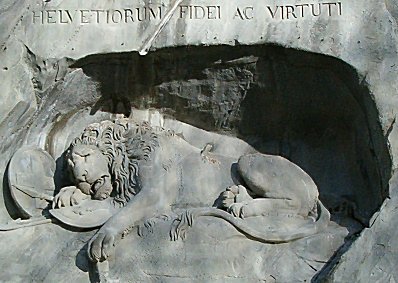Famous Swiss Monument
In Lucerne, Switzerland I fell in love
with the country’s famous Lion Statue. Each time I’m in the city I have to
visit one of the most famous monuments in the world.
During the French Revolution 40,000 Swiss
served under foreign banners. When a man retired, his son inherited his father’s
commission, and the Foreign Legion was big business in those days.
 Swiss mercenaries were killed in 1792 on
the Tuileries Palace steps while
defending King Louis XVI. About 25-years later, in 1819, in Rome, Bertel
Thowaldsen designed the lion as a tribute to his fallen Swiss countrymen.
Swiss mercenaries were killed in 1792 on
the Tuileries Palace steps while
defending King Louis XVI. About 25-years later, in 1819, in Rome, Bertel
Thowaldsen designed the lion as a tribute to his fallen Swiss countrymen. Lucus Ahorn was commissioned to be the carver. In 1820-21 when he carved the monument out of a sandstone hillside, the area was in the countryside, well away from the city center. Today the six-meter (19.5 feet) high and 10 meter (39.5 feet) long monument is in the center of Lucerne. An arrow protrudes from the lion’s back, a tear runs down his cheek, and a paw lies across the Swiss shield, protecting even in death.The powerful larger-than-life memorial brings tears not only to my eyes, but to nearly everyone who sees the wonderful statue.
